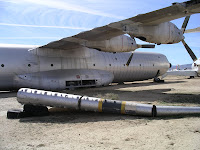Santa Maria to Hilo 17/3/2010
Skies were clear and blue for most of the 14.1 hours we flew from Santa Maria to Hilo. However, the forecast for Hilo itself was for broken cloud at 2500', so out came the approach charts. Approaching from the east is fine as you are over water and the airport is on the eastern side. However, right on the western side looms the tall mountains around the volcano. We split up and descended through the cloud, coming out over the water, east of the airport and followed each other, joining base as instructed.Hilo airport on a good day (above)
Hilo airport on our arrival (below)
Hot and humid with passing heavy showers. We unpacked between showers, sheltering behind the fuel trucks during the heavy showers. During the flight Ray had discovered a small weeping leak in the fuel bladder caused by being pinched by putting the pilot's seat back. Jose got into the back and moved the bladder so that the puncture was at the top. The local LAME was brought in to repair the bladder and secure the knob on the Saratoga's rudder trim. Dan had used 5 quarts and had 3 remaining. I cleaned Lyn's window and noted that the specks were greasy and looked like grease rather than oil. The aircraft were refueled and we
 headed for the hotel and a lay day.
headed for the hotel and a lay day.Rained most of the next day so we retired to our rooms for the day.
Repaired and inflated fuel bladder
Next morning we planned a 'late' 7:30 am take off as the flight south to Christmas Island was the shortest leg of the trip.
Checking the Saratoga I noticed a slight discolouration around the right air intake and pointed it out to Lyn who said not to worry about it as it was fairly normal. At the time we didn't associate it with the specks on the windscreen.
If Lyn had palpitations when the speed brakes came on, she was about to have a much higher level of anxiety.
Depart Hilo 19/3/2010 - Arrive Christmas Island 20/3/2010
Whereas my Turbo Arrow requires little right rudder pressure on taxi and take off, the Saratoga required left rudder on taxi gradually going to right rudder during the take off. It is also much heavier than the Arrow.Rolling down the runway and reaching about 80 knots, the Saratoga swung quickly - almost violently - to the left and the grass verge loomed until more right rudder and we were back on the centreline. Lyn said "You certainly got my attention there".
No time to think about what had happened. We were into the cloud and turning south. We went west to keep out of the way of the aircraft ahead. Our allocated block level was between 6000' and 8000'.
On the way down Lyn's windscreen had much heavier specks than the day before. We couldn't work out what it was or where it was coming from. I suggested it may have been refrigerant oil from when the gas was removed from the airconditioner.
Little bits of cloud approaching Christmas Island and we came down to 1500' about 15 NM out.
Cassidy International Airport is nothing like Los Angeles. It has one flight in on a Tuesday and one flight out on a Tuesday. Notwithstanding, we were met and greeted by the Customs Officers and processed the paperwork before returning to refuel from the drums.
Cassidy International Airport, Passenger Terminal and Customs Offices
On the walk around the Saratogo, I noticed that the slight discolouration was now a thick greasy substance a couple of millimetres thick around the right air intake. It looked and felt like grease, but we were not able to find where it was coming from. No LAME, no facilites, sitting here for 3-6 weeks wasn't an exciting prospect.
Drum refueling at Christmas Island - think it cost over $1000 per drum
We were not able to contact Mark Howe of Blue Demon (Saturday in Australia) and we contacted Tom McCrea in LA on the satellite phone. Tom told Lyn not worry about it and just fly on. "What is it?" I asked. "He didn't say". I then rang Tom and asked what it was and where it came from and was told "I don't know. It could be oil". All I know is that if oil comes out of the engine and if there is no oil, the engine stops.
Finally got Mark Howe who was brilliant. "Saratogo. Will have a Hartzell prop. Is there grease up the back of one of the blades? "Don't know" I replied. "Well if it is on the windscreen it is not likely to be oil from the seal as that will go back over the engine. If it is grease from the prop hub it is likely to go up the back of the blade and flick onto the windscreen. If it is grease you can fly for 100 - 200 hours. If it is oil you will have 1 - 2 hours before the engine stops.
First check in the morning was the back of the blades. The first two were clean but the third had streaks of grease running up from the hub.
Click on image to enlarge

























